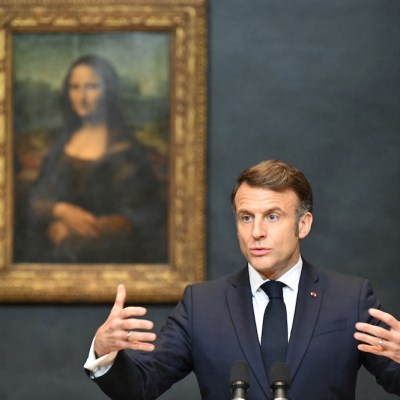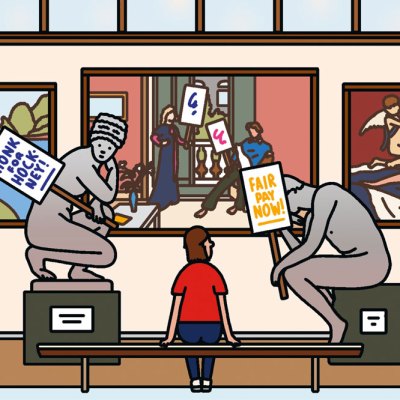On Thursday, the French prime minister, François Bayrou, had his budget approved by the French Senate after surviving two no-confidence votes in the lower house, the National Assembly, the previous day. The budget requires spending cuts of €30bn and tax rises of €20bn to reduce France’s budget deficit from 6 per cent of GDP to 5.4 per cent in 2025. (The failure to pass a budget to get the deficit down to 5 per cent brought down Michel Barnier’s government in December.) The ministry of culture’s budget – which stood at €4.4bn in 2024 – has been cut by only €150m, but the much greater shock to the arts sector is the €2.2bn cut to local government. On Wednesday the Académie des Beaux-Arts issued a statement warning against the proposed cuts and denouncing the ‘violence and total lack of consultation’ in what it describes as unilateral decisions by local authorities, some of which have already slashed their arts funding. It called for local politicians to treat artists with respect and for artists to argue for the financial benefits of the arts in future debates. At the end of January, the trade union representing workers in the performing arts, Syndeac, asked the culture minister Rachida Dati about the cuts to her department, which come after a €200m reduction last year. A petition called ‘Stand up for Culture’ has already attracted 40,000 signatures from figures across the arts, and protests and industrial action are expected.
The Brooklyn Museum is to lay off more than 40 employees, some 10 to 13 per cent of its total workforce, it confirmed to the New York Times on Friday. On Thursday Hyperallergic first reported that the president of Local 1502, part of the American Federation of State, County and Municipal Employees, which represents 130 workers at the institution, had learned of the layoffs before an all-staff meeting scheduled for the next day. The museum’s director Anne Pasternak explained in a letter to staff that the cuts were necessary to address a $10m operating deficit before the end of the financial year in June. She cited the effect of inflation and a slow recovery after the pandemic as key factors and the fact that staff costs accounted for 70 per cent of the operating budget, saying that ‘a financial realignment sadly requires a reduction in our team’. The announcement comes at a difficult time for the institution. In May, 34 protestors were arrested at a pro-Palestinian demonstration at the museum, which itself criticised the NYPD’s heavyhanded tactics. In mid June, two activists were charged with hate crimes for vandalising the homes of Pasternak and museum board members. The Brooklyn Museum is currently celebrating its 200th anniversary with a series of special exhibitions and events and a new brand identity, which it unveiled last September.
The crypto-currency entrepreneur Justin Sun is suing David Geffen for the return of a Giacometti sculpture, Le Nez, which, Sun alleges was sold by an art adviser to Geffen without his consent, reports the New York Times. In court papers filed in Manhattan on 4 February, Hong Kong-based Sun, who hit the headlines last year for buying Maurizio Cattelan’s banana artwork for $6m and then eating it, claims that his former advisor, Xiong Zihan Sydney, forged signatures and send fraudulent emails to make the sale without his approval. He also claims that the sale of the sculpture for $65.5m falls far below the $80m he told Sydney he was prepared to sell it for; Sun paid $78.4m for the work in 2021. He now seeks the return of the sculpture or $80m in damages; his claims, however, have been labelled ‘bizarre and baseless’ by Geffen’s lawyer Tibor L. Nagy, who has stated that Sun was fully aware of the deal and has suggested that he was experiencing ‘seller’s remorse’.
On Tuesday (4 Feb), Christie’s withdrew a painting of Saint Sebastian by El Greco of c. 1610–14 from its Old Masters sale in New York, after the intervention of the Romanian government, reports Artnews. At the end of January, Romanian Insider, an English-language online publication, reported that the prime minister of Romania, Marcel Ciolacu, and a team of lawyers are claiming the return of the painting through the Paris Judicial Tribunal. Their argument is that the work, which was acquired by King Carol I of Romania in 1898 and stayed in the country until 1976, when it was sold to Wildenstein & Co., is ‘unequivocally the property of the Romanian state’ and part of its patrimony. The anonymous consignor of the work to Christie’s bought the painting from a now-disbanded art advisory group in 2010. In a statement to the Art Newspaper on 6 February, Christie’s said that it had withdrawn the painting – which it had valued at between $7m–$9m– ‘out of an abundance of caution’ and that it ‘look[ed] forward to selling this unique and spectacular work at a later date.’



